The Ithaca Gun Company introduced their “Auto & Burglar” model of side-by-side shotgun in 1922. This was not the only gun of its type made for the commercial market, but it was one of the better ones, and is probably the best remembered type today. The premise was simple: take a standard SxS shotgun, cut the barrels down to 10 inches (255mm) and replace the stock with a pistol grip. Presto, you have an intimidating and compact defensive weapon.
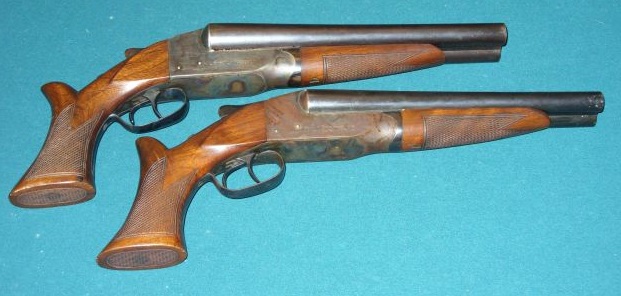
When introduced in 1922, there was no particular legal status for a firearm of this type, although the passage of the National Firearms Act in 1934 effectively ended their production and sale (they sold for typically about $40, and the NFA placed a $200 tax on their transfer). They actually didn’t sell all that well before the legislation – only approximately 4500 were made between 1922 and 1934, and not all of those were sold (unconfirmed rumor is that the remaining stock was sold to the UK after Dunkirk, when the British were desperate for firearms of any sort).
Two primary models of the Auto & Burglar were made, as Ithaca introduced a new SxS shotgun action in 1925 (and the Auto & Burglar was simply a conversion of standard factory actions). The early guns (1922-1925) are easily distinguished by a prominent spur on the grip, which was designed to prevent the gun from rolling in the hand upon firing. However, that spur proved to be a bit fragile, and easy to hit on things and break. When the new action was introduced in 1925, the Auto & Burglar grip was redesigned to have a much more squared-off grip, without the spur to potentially damage (it was also a less expensive grip for Ithaca to make). The barrel length was also increased to 12.2 inches (310mm) around the same time – the later style guns can be found with both long and short barrels.
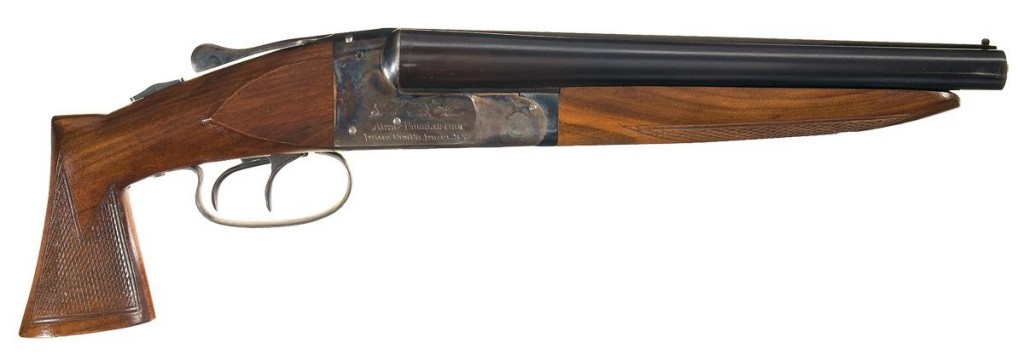
Despite these changes, the standard Auto & Burglar throughout production was chambered 20 gauge shells (2.5 inch in the early guns and 2.75 inch in that later ones), with cylinder bores and double triggers. There are a few references to .410 and 28 gauge examples, but I have been unable to find any suggestion of a 12 gauge version. That makes sense, given the punishing recoil such a gun would have – but it is odd in light of a set of photos I was recently sent by a reader (thanks, Robert!). This fellow has a pair of Auto & Burglar guns (both legally registered) which he inherited from hist grandfather. One is a standard 20 gauge example, and the other is a bona fide 12 gauge version:
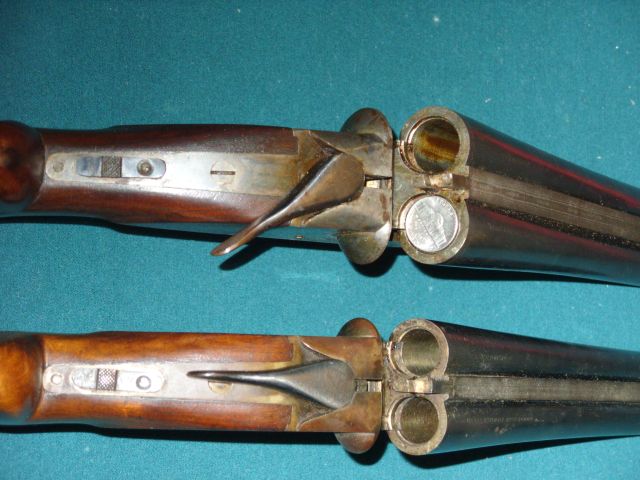
Since the Auto & Burglar was made from stock shotgun actions, there is no reason why a 12 gauge version could not have been easily made by special order, and that is almost certainly what happened in this case. The gun otherwise appears identical to a typical example.
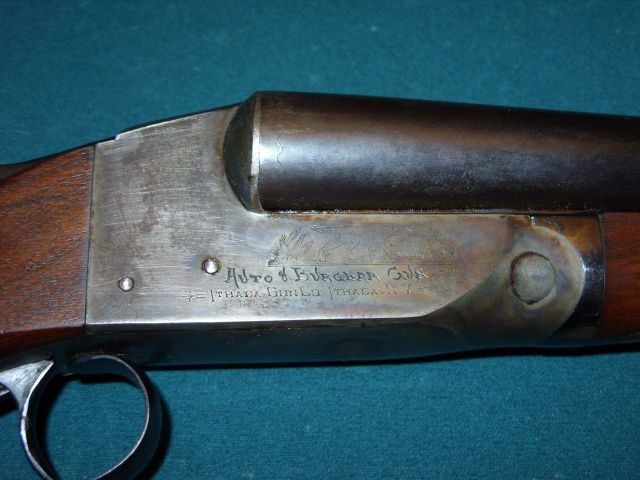
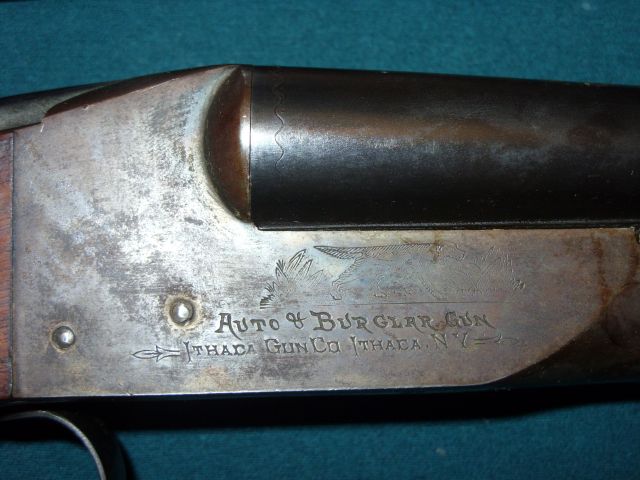
The early guns are generally referred to as Model A and the later ones as Model B, although these are designations created by the collecting community and were not applied by Ithaca. Ithaca also marketed a flap holster for the gun, which is a fairly valuable accessory today. According to the catalog it was, “A special designed sole leather holster which may be attached to one’s belt or hung in a convenient place in an auto, sleeping room or bank – costs $4.00.” A couple Chicago banks were in fact some of the first buyers for these guns, as this was also prior to FDIC insurance to protect banks from robbery.
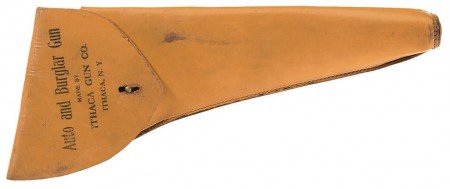
If anyone has additional information on 12-gauge examples of the Auto & Burglar, I would be very interested to hear it!

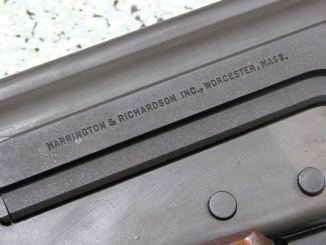
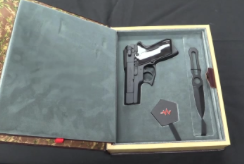
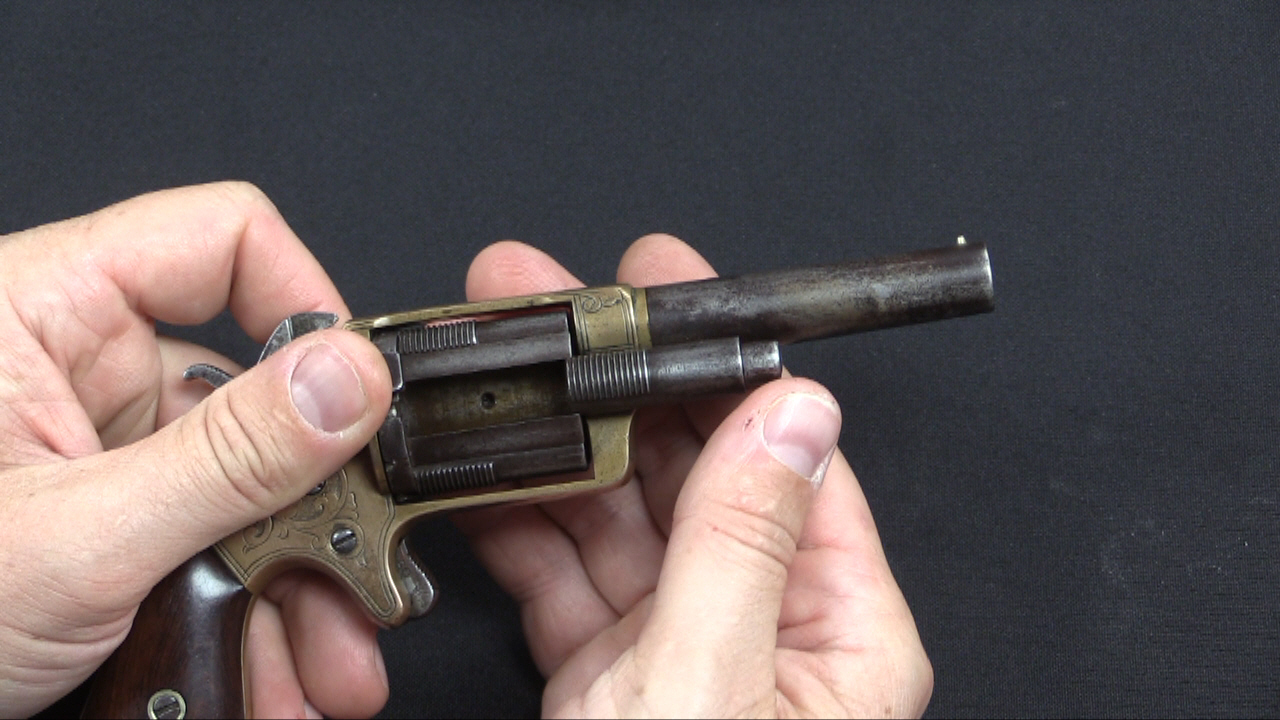
Just looking at the picture of the 12 gauge makes my hand hurt!
I doubt that there was any low recoil buckshot loaded back in the day. At least I have not seen any listed in old ammunition catalogs.
They did load #1 buck in 20 gauge a century ago. I wish they did now. That would be my load of choice for the Auto & Burglar gun.
Re: 20 gauge shells with #1 buckshot. This loading is currently being made by Rio which is a Spanish company. The load is three layers of three #1 pellets. the top of the shell is clear plastic so you can look at the top layer. The box says 1345 feet per second. I purchased two 25 round boxes at a gun show about six months ago for $11 per box, and two more a few weeks ago at another gun show for about $15 a box.
In some industries companies seek out “diversion” markets, where a product with a defect can be salvaged and sold to a different market, with the consumer none the wiser. I wonder if the reason this was introduced was because there was demand for short double shotguns, or if maybe the factory produced a few dozen full size shotguns every month and the barrels were not sufficiently hitting the same point of aim, the soldering job came apart in the bluing tank, end of barrel got dented, etc? Whack the barrel off and put on a different grip, and sell it as-is instead of having a gun smith spend half a day working it over?
When trucking was a lucrative business, and the cargo ……..worth more than years wages, protection was needed by drivers and co-drivers. To shoot a gun in the cab of a truck was tough to aim and tougher to control……a need for quick aim and fire was filled by the manufacture of this shotgun. The .20 ga. could take out a door window and the second round into the torso of a hi-jacker.
These are classified as ‘Any Other Weapons’ in Title II and only require a $ 5.00 tax to transfer. They were originally made as a shotgun pistol and were not converted from a full size shotgun. It would, however, require a $ 200.00 tax stamp to manufacture and register one of these today.
Today, yes, but back in ’34 the transfer tax for an AOW was $200. It was dropped to $5 in 1960.
No, a gun made today that fires a shotgun cartridge and is manufactured with a pistol grip only, and can have a short barrel, is an AOW with $5 tax stamp.
With a rifle stock is a SBR and $200 tax stamp.
With an original pistol grip and a 14 inch barrel and an overall length of not less than 25 1/2″ is not an NFA firearm and not a shotgun either according to BATF
It does remind me some of the Iver Johnson Enforcer and the Charter Arms Explorer II pistols, both of them being rifle actions remade into pistols. The Iver Johnson using an M1 Carbine action and the Explorer using an AR-7 action. Growing up in the 1980’s, when it was in the Charter Arms catalog, the Explorer had a neat Star Wars / broom handle Mauser look to it, but by all accounts the trigger left something to be desired.
an the aluminum receiver was easily broken rendering the entire thing just junk
to be salvaged
Two points;
Yes, your theory of a diversion market could well be true. But, barrels at that time did not come apart in the bluing tanks, because hot salts bluing had not been developed at that time. DWM introduced the process in 1937. Prior to that, there was rust blue and several variations on heat blue.
$40 seems a pretty stiff price for the time. I would hate to pay 2 double eagles for one of these shotguns, even as cool as they are. Not fair to directly compare 1920s gold prices to today’s gold prices, but if I had a time machine, and could go back to the 1920s with today’s gold, that gun would cost me about $2500. Just for the gold, not considering any numismatic premium.
Probably explains why they didn’t sell very many, and why they were willing to make custom examples.
CPI inflation calculator http://www.bls.gov/data/inflation_calculator.htm says $40 in 1922 would be $566.43 in today’s dollars. However, CPI does not tell everything.
1922 Model T Runabout: $319
You could buy 8 of these guns or a Model T.
http://www.cabincreekcds.com/stevensno.55.htm
states following prices for Stevens double shotguns (1920):
$35.00 for No. 345 (Hammerless, 20 gauge only)
$33.00 for No. 335 (Hammerless, 12 and 16 gauge)
$25.00 for No. 215 (Hammer, 12 and 16 gauge)
They didn’t call it the “roaring ’20s” for nothing. Available during the era of highway bandits when you could get Thompson SMGs and BARs via mail order. Those Ithacas seem to be of dubious utility (although I am sure that they are effective close range killing machines) but I can’t help but want one (or the modern equivalent, a Serbu Super-Shorty)!
According to the Law Enforcement Handgun Digest (Digest Books, 1972), in 1971 Holland Firearms Inc. of Houston TX (run by one R. Bruce McCarty)arranged for at least a limited production run of Auto & Burglar repros in 20 gauge to be manufactured in Spain (probably by either Gabilondo y Compania or AyA). They were imported into the U.S. for law enforcement sales only, and were apparently intended mainly as heavy-duty backup guns for stakeout details and undercover narcotics units.
Dean Grennell and Mason Williams, the authors, tested one of the “new” A&B 20’s, and found that the best way to use it was to fire from the Weaver stance, holding it with both hands. The off hand had to be firmly wrapped around the forend and pulling downward (as with a Thompson on full-auto) to prevent the gun from going straight up and backward due to recoil. Firing with a “conventional” pistol type two-hand hold netted Grennell a knot on the noggin from the front end of the little beast.
Firing from the hip was also effective, and since the sights were well below the eyeline there was no reason not to wrap the fingers of the off hand around the top of the barrels to keep a firm grip on the gun. The result, I suspect, was rather like James Caan as Mississippi in El Dorado (1967) with John Wayne and Robert Mitchum.
It wasn’t a long-range weapon by any means, but up close it beat just about anything else for “stopping power”- at both ends.
cheers
eon
You can get leather hand guards which slip over the barrels/forestock, enabling you to grip sawn off’s in an over hand fashion at waist height as you allude to eon more effectively. 12 bore sawn off’s are very British, Britain not having many handguns of other types seemingly with London Gangsters apples and pears etc.
A friend’s father had a registered “copy” made back in the 1960s (from a 12 ga. Stevens sxs) for home protection. It was a legal sawed off shotgun, but the stock was simply a cut down and sanded pistol grip w/o the spur. My buddy still has the scar from where the break-open lever embedded itself in the web of his hand after we dared him to fire both barrels at once. IIRC, Ithaca later made a cut-down version of its Model 37 pump gun called the Auto and Burglar as well. Ricardo Tubbs (Philip Michael Thomas) carried one on the old TV show, “Miami Vice.”
I seem to remember a discussion about this very same shotgun and its interesting history over at http://www.thefirearmblog.com quite awhile back, courtesy of Phil White ( who simply loves and appreciates traditional and vintage firearms as much as any of us ) and company. I remember commenting at the time about how policeman Jim Malone — played by Sean Connery — in the 1987 remake of “The Untouchables”, was supposed to be armed with a sawn-off Ithaca Auto & Burglar 12-gauge in the scene where he was assassinated, except that in this case the directors / producers substituted a similar-looking Rossi double-barreled 12-gauge, probably for simple logistical reasons.
Despite the Auto & Burglar name note that this gun can be also used as a “pocket” shotgun like say Marble Game Getter for survival hunting purposes or for defense against big wild animals like Howdah pistols. The idea of (relative) small handgun chambered for powerful cartridge is very old and still live (for example see .45-70 derringer)
I wasn’t aware of the .45-70 Derringer even existing before you mentioned it… And here I was thinking .45-70 in a revolver was already as crazy as it would get.
Yes, the American Derringer Co.’s “Alaskan Survival” model. Local gun shop owner ordered one for himself as a sort of joke. I had a chance to shoot it. I declined. (Not that I am recoil sensitive. I have a 6″ barreled S&W 500 that I shoot fairly regularly, but that thing just seemed dangerous on both ends.) I reckon some idiot somewhere is trying to figure out how to make one in .50 BMG.
So, what would 2 (1 type A & 1 type B) be worth today?
Both registered & in excellent condition?
I worked as a deputy sheriff/detective sergeant in Northern CA from 1968 to 1982. As department armorer, I found one of the early 20 Gauge A&B models (with leather scabbard) in the storage closet. It was in excellent condition and appeared to have never been fired. I appropriated it as my ‘raid gun’ serving warrants, loaded with #1 Buck.
It would pattern inside a 30″ circle at 20-30 feet, had recoil compared to a .44 Magnum revolver. It scared the bejeesus out of anyone who looked at those barrels; one guy wet himself when I aimed it his way …
An Undersheriff came along in the late 70’s and acquired it from me, letting it rust and corrode in his vehicle trunk.
As a footnote, we had two M1928 Thompsons from the Bootlegging Days and that storage room had boxes and boxes of Thompson 20 & 30 round magazines in wrappers, a few 50 round drums, and thousands of .45 ACP Ball military ammo in the ‘spam’ cans. I had some fun times at the range with all that
What’s the value on the b model I just inherited one from a family member?
I remember seeing a 12 gauge double pistol at the Eisenhower Museum in Abilene Kansas. This was about 50 years ago, and I didn’t see it on a more recent visit.
My dad had an A model in 28 Ga. which he sold to a collector many years after acquiring it in the ’50’s. I wish I had it back. The collector was asking if we knew of any 28 Ga. buck shot to go with it for the display. I am sure that some were manufactured back then. Of course, I would not mention his name, but maybe he will see this post and will contact me.
i believe that the tax for any other weapon in 1934 was $200. in 1938 at the NRA’s urging the tax on any other weapon was lowered to $1. In 1960 the $1 tax was raised to $5
I knew someone, back in the late 70’s that had just a complete receiver, was in an old gun repair shop from the 40’s, 50’s, Now I wonder if all the other parts were also there, scattered around, or hidden away. that one had much neater Auto & Burglar Gun, stamped on both sides, along with Ithica Gun Co, Ithica NY. Whereas the models shown here look much like the auto and burglar script was hand scribed. Am wondering if it may have been the later 1960’s type, any info appreciated. Thanks.
Hi Harry, hope you’re still around and will answer my question, what old gun shop, and what town and state ? by chance was it in Castro Valley Ca. ? as I seem to remember seeing one many many years ago and remember the owner was going to throw it away.
would this be a non NFA if produced today as a 20 gauge handgun ?
I recently acquired a.410 hammer version of the Auto & Burglar in a bulk parts buy. The wooden parts and receiver parts are rusted out leaving the two barrels & receiver with two triggers. I am looking for a collector of these guns, Jim in Memphis
Not sure how it made it to Australia but there is a Model B 12g that has just come up for sale here for $1995AUD
I imagine it would be impossible to import into the USA given the restrictions on this type of firearm but here’s the link for anyone interested.
https://usedguns.com.au/gun/487215/